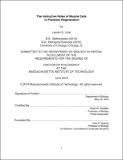The instructive roles of muscle cells in planarian regeneration
Author(s)
Cote, Lauren E.(Lauren Esther)
Download1117709828-MIT.pdf (91.58Mb)
Other Contributors
Massachusetts Institute of Technology. Department of Biology.
Advisor
Peter W. Reddien.
Terms of use
Metadata
Show full item recordAbstract
Regeneration requires both new cell production and patterning information to correctly place new tissue. Planarians are flatworms with remarkable capacity to regenerate after nearly any injury and to indefinitely maintain tissue homeostasis. Dividing cells, neoblasts, are the source of all new tissue, whereas positional information is hypothesized to be harbored by post-mitotic muscle, including the subepidermal body wall musculature. Single-muscle-cell mRNA sequencing along the anterior-posterior axis revealed regional gene expression within muscle cells. The resulting axial gene expression map included FGF receptor-like (FGFRL) homologs and genes encoding components of Wnt signaling. Two distinct FGFRL-Wnt circuits, involving juxtaposed anterior FGFRL and posterior Wnt expression domains, controlled head and trunk patterning. Inhibition of FGFRL-Wnt circuit components led to the formation of ectopic posterior eyes or secondary pharynges, indicating their importance in maintaining the anterior-posterior axis. Inhibition of different myogenic transcription factors specifically ablated orthogonal subsets of the body wall musculature. Longitudinal fibers, oriented along the anterior-posterior axis, are required for regeneration initiation. Circular fibers maintained medial-lateral patterning during head regeneration. During early regeneration, transcriptional changes in muscle cells comprised part of a generic wound response displayed by all injuries, from incisions to decapitations. The sole exception to this generic response was the expression in body-wall muscle of the Wnt inhibitor notum, which occurs preferentially at anterior-facing wounds in longitudinal muscle fibers. Therefore, anterior-posterior polarity, the choice of head or tail regeneration, involves longitudinal body wall muscle fibers. Planarian muscle were found to be highly secretory. Combining an in silico definition of the planarian matrisome and recent whole animal single-cell transcriptome data revealed that muscle is a major source of extracellular matrix (ECM). Inhibition of hemicentin-1 (hmcn-1), which encodes a highly conserved ECM glycoprotein expressed in body wall muscle, resulted in ectopic localization of internal cells, including neoblasts, outside of the muscle fiber layer. ECM secretion and maintenance of tissue separation indicated that muscle functions as planarian connective tissue. Whereas muscle is often viewed as a strictly contractile tissue, these findings reveal that planarian muscle has specific regulatory roles in axial patterning, wound signaling, and tissue architecture to enable correct regeneration.
Description
This electronic version was submitted by the student author. The certified thesis is available in the Institute Archives and Special Collections. Thesis: Ph. D., Massachusetts Institute of Technology, Department of Biology, 2019 Cataloged from student-submitted PDF version of thesis. Vita. Includes bibliographical references.
Date issued
2019Department
Massachusetts Institute of Technology. Department of BiologyPublisher
Massachusetts Institute of Technology
Keywords
Biology.